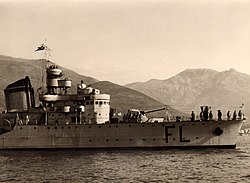| Battle of the Duisburg Convoy | |||||||
|---|---|---|---|---|---|---|---|
| Part of The Battle of the Mediterranean of the Second World War | |||||||
 Italian tanker Minatitlán on fire and sinking at dawn, 9 November 1941 | |||||||
| |||||||
| Belligerents | |||||||
| Commanders and leaders | |||||||
| William Agnew | Bruno Brivonesi | ||||||
| Strength | |||||||
| 2 light cruisers 2 destroyers | 2 heavy cruisers 10 destroyers 7 merchant ships | ||||||
| Casualties and losses | |||||||
| 1 destroyer damaged | 1 destroyer sunk 2 destroyers damaged 7 merchant ships sunk | ||||||
 | |||||||
The Battle of the Duisburg Convoy (Battle of the BETA Convoy) was fought on the night of 8/9 November 1941 between an Italian convoy, its escorts and four British ships. The convoy was named BETA (Duisburg refers to the largest ship) by the Italian naval authorities and carried supplies for the Italian Army ( Regio Esercito ) civilian colonists and the Afrika Korps in Italian Libya.
Contents
- Background
- Italian belligerence
- 1940–1941
- Unternehmen Sonnenblume
- Malta
- Prelude
- Duisburg (BETA) convoy
- Force K
- 7–8 November
- Battle
- 8/9 November
- 9 November
- Aftermath
- Analysis
- Italian order of battle
- Axis merchant ships
- Convoy escorts
- British order of battle
- Force K 2
- Notes
- Footnotes
- References
- Further reading
- External links
Force K of the Royal Navy, based at Malta, was sent to attack the convoy based on information gleaned from decrypts of Axis signals coded on the Enigma machine, covered by the fortuitous flight of a reconnaissance aircraft. The convoy was annihilated and the destroyer Fulmine was sunk, with no loss and almost no damage to Force K. The Maestrale-class destroyer Libeccio was sunk next day by the British submarine HMS Upholder, while picking up survivors.
The Italians were severely criticised by the German naval attaché and pressured to accept liaison officers at Supermarina (headquarters of the Regia Marina ) and on its ships. Italian attempts to reduce the risk of interception by British forces, by sending individual ships, pairs and smaller convoys from several ports at once was futile, because the British were reading Italian naval codes; the next convoy was forced to return to port.



